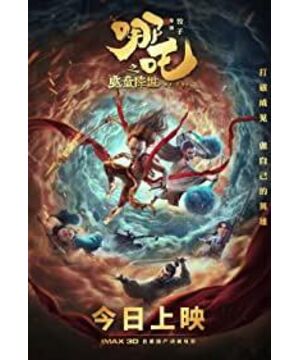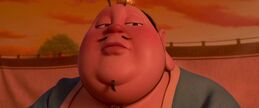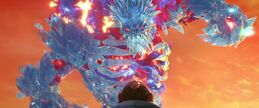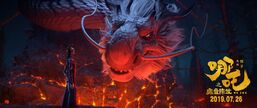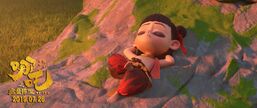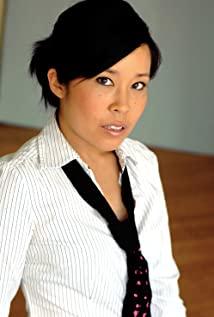"Nezha's Devil Child Comes into the World" unsurprisingly detonated the summer theater and became the most popular film in the summer.
In the trailer, the image of Nezha, known as the "ugliest in history", has surprised many viewers, and it is a bit far from the healthy and lovely child in public perception.
However, the "traditional image" in the public perception is not the true face of Nezha. Nezha's image has been undergoing changes, and the things he fought and rebelled against have also been changing.
This "Nezha's Devil Child Comes into the World", which detonated the summer file, is not so much a salvage and inheritance of the image of Nezha in traditional culture, but rather borrowed the shell of Nezha's IP, based on the Western fantasy literature tradition and Hollywood. An adaptation of the blockbuster narrative logic. From the initial resistance to the feudal system, to safeguarding the interests of the common people and resisting the destiny, and then to resisting the shackles of destiny in "Nezha's Devil Child Comes into the World", and then achieving self-redemption and growth. Ne Zha's struggle reflects the living conditions of human beings in each era. The unsuccessful struggle at the end actually gave Nezha some contemporary Sisyphus implications.
Written by | Guo Yemin
The evolution of Nezha's image
From India to China
"Nezha" in "Nezha" is different from the usual pronunciation, but it rhymes with "A" in "Namo Amitabha". Like Tathagata Buddha, "Nezha" was also imported from India to China. Prof. Meir Sha-har, a doctor of literature at Harvard University and a professor of East Asia at Tel Aviv University in Israel, believes: "Nezha is a combination of two gods in Indian mythology, one is the Yaksha in the Ramayana, and Zhakvara. Another archetype is Lord Krishna". In Indian Buddhism, the full name of "Nezha" is Nazha Kuvara (or Nara Kūvara, Sanskrit Nala Kūvara), the third son of the Northern Protector of the Kingdom of the Four Heavenly Kings of Buddhism. He looks like a ghost king with three faces and six arms, whose duty is to protect the Dharma, sweep away evil, and protect the world.
This image is both awe-inspiring and awe-inspiring. In order to make it easier for the Chinese to accept, Nezha's image changed again and again, and finally changed beyond recognition. During the Southern Song Dynasty, Li Jing, a famous general in the early Tang Dynasty, was deified as a Buddhist Bishamon, and Nezha, the prince of Bishamon, naturally became of Chinese blood. It is worth mentioning that it was also the eminent Zen monks of the Southern Song Dynasty who first created the famous legend of "that (where) cut off the bones to return to the father, cut the flesh to return to the mother", which was later used by Xu Zhonglin (controversially) in "Feng Yi". In the Romance of God.
In the Ming Dynasty, Nezha's identity was transformed into "Daluo Immortal under the control of the Jade Emperor" in the book "Three Religions Sou Shen Daquan" written during the Yongle period. In this way, after Nezha changed from an Indian to a Chinese, he converted from a Buddhist deity to Taoism, which is a complete localization. Nezha written by Wu Chengen in "Journey to the West", "the dragon species is naturally not a vulgar image, and the young age is not like the ordinary world", and its image has also changed from a ghost king to a graceful and beautiful boy. Even the name "Nezha" was localized by Wu Chengen. "Journey to the West" explains the origin of Nezha's name in Chapter 83: "He has the character 'Nezha' on his left palm and the character 'Zha' on his right palm, hence the name Nezha". To be honest, the logic of this explanation is as ignorant as "because she was born in Jingchu, so she is called Mengmeng", but at least it makes readers forget the Sanskrit source of "Nezha".
Nezha in "Journey to the West" is already the "Santan Haihui Great God" under the Jade Emperor's account, and he served as the vanguard in the crusade against the Huaguoshan rebel Sun Wukong. Judging from the storyline of Nezha, another Ming Dynasty novel "Fengshen Romance" can be regarded as a prequel to "Journey to the West". The novel takes three full chapters (12-14) to create a complete plot of Nezha's birth experience. From the reincarnation of Lingzhuzi to the apprenticeship of the real Taiyi, making a scene in the East China Sea, shooting Shiji by mistake, deboning and gouging out the meat, showing the saint on the screen, the incarnation of lotus, and finally becoming the vanguard of Jiang Ziya's crusade against King Zhou of Shang.
For contemporary audiences, although both "Journey to the West" and "Romance of the Gods" have been adapted for film and television more than once, the most popular image of Nezha is probably from the cartoon "Nezha in the Sea". The film largely follows the story in "Fengshen Romance", but at the same time it also makes a very important adaptation.
When it comes to "adaptation" in cartoons, it is impossible not to mention the original setting in "Fengshen Romance" first. Although the literary value of this novel cannot be compared with that of "Journey to the West", it is commendable that the author has created a complete system of immortals through his rich imagination. In traditional Chinese culture, Confucianism pays attention to "the child does not speak, strange power, and chaos", but Taoism does the opposite, taking "cultivating immortals" as its own responsibility, and gradually forming a clear and huge pedigree of immortals. Whether it is "Fengshen Romance" or "Journey to the West", many immortals can see the shadow of Taoist culture.
But there are also differences. In Taoism, "Sanqing (Yuanshi Tianzun, Lingbao Tianzun, and Daode Tianzun)" are the supreme gods of the heavens. Tao Hongjing of the Southern Dynasty enshrined "Yuanshi Tianzun" as the first-order median main god in the "True Spirit Position Industry Map". In the "Book of Sui Books", even the high-ranking gods such as Taishang Laojun became the disciples of Yuanshi Tianzun, establishing Yuanshi Tianzun's supremacy in the Taoist gods' lineage. But in "Fengshen Romance" or "Journey to the West", the situation is different. In Taoism, the Jade Emperor, the head of the "Four Imperials" (i.e. Haotian God), whose status is under the "Three Qings", surpassed the former and became the ruler of the immortal world. In "Fengshen Romance", it is the immortal who violated the precepts and shook the heaven; for this reason, "Haotian God" instructed Yuanshi Tianzun to lead the organization responsible for selecting talents to serve as grass-roots leaders (ie "Fengshen"). Similarly, in "Journey to the West", the Jade Emperor is also the supreme ruler of the heavenly court.
Probably due to the long-standing habit of feudal autocracy over two thousand years, the novelists of the Ming and Qing dynasties could not imagine another possibility for the ruling order of the heavens. Therefore, the heavenly court composed of gods in the novel has become the epitome of the court on earth. The supreme Jade Emperor symbolizes the imperial power in the world, "Marshal Tota" represents the noble class of the imperial family, "Erlang God" and other gods will mean the force to maintain the imperial power. And the fairies and boys who were called to and fro by the relatives of the royal family and the gods, didn't they compare to those maids and servants?
It is precisely because of this background of "harmony between man and nature" that it is not surprising that Nezha's performance in "Fengshen Romance" just fits the ethical concept of the feudal era. The so-called "monarch, ministers, fathers, sons" means that individuals do not have independent identities, and people of different levels have a personal attachment relationship, and there is no physical freedom at all. Therefore, after Nezha's big disaster (killing Longgong Ao Bing), he chose to "open the abdomen, cut out the intestines, remove the bones and meat, return it to the parents, and not tire the parents", which shows the traditional Chinese culture of "filial piety first." "traditional concept. Although Nezha cut off his connection with the secular family through extreme forms of resistance such as self-mutilation and suicide, his father, Li Jing, finally obtained a pagoda that could subdue Nezha from Daoist Ran Deng. Nezha's body was under the weight of the pagoda symbolizing feudal culture, and he did not resist. As a result, the traditional father-son, monarch-subject relationship in the feudal era was still maintained.
Nezha's film and television IP changes
Rather than inheriting the tradition,
Rather, it is closer to Western fantasy literature
In the cartoon "Nezha Nao Hai", Nezha's resistance has a more profound connotation.
Nezha in "Fengshen Romance" is based on the feudal human relationship to return the body to his parents, while Nezha in the cartoon is a heroic suicide for the benefit of the whole city. Different from the original work, at that time he did not know that he could be reborn, and his behavior was not bound by feudal ethics, but a noble act of daring to sacrifice himself at a critical moment. In the original book, Nezha chases and kills his biological father to repay the hatred of not being able to reincarnate. In the movie, the new Nezha grows into a hero who symbolizes modern spirits such as light, justice, and fearlessness. He smashed the plaque of the Dragon King Temple and destroyed the "Crystal Palace". Killing the Dragon King was no longer based on personal hatred, but so that the people of the city would no longer be persecuted by the Dragon King and other feudal evil forces.
This kind of treatment is easy to remind people of the similar adaptation of "Journey to the West" in another domestic animation masterpiece "Havoc in Heaven" - Sun Wukong was not pressed by the Buddha under the Wuzhi Mountain as in the original book, but was marked on the Lingxiao Palace. , turned the heavens upside down. Like Sun Wukong, Nezha in "Nezha Raising the Sea" also rebelled against the entire feudal system in order to bring opportunities for survival and development to the common people.
To a certain extent, today's "Nezha: The Devil's Child Comes into the World" and "Nezha Raising the Sea" a few decades ago may not be comparable to each other. This is because the setting in "Nezha's Devil Child Comes to the World" is hardly inherited from "Fengshen Romance" or even traditional Taoist culture, but has many similarities with contemporary fantasy literature.
This point actually shows up in some of the appearances of "Nezha's Devil Child Comes to the World". In Taoist culture, there are a large number of fairy beasts in the "heaven". For example, Qinglong, Suzaku, Baihu, and Xuanwu are the gods of the four directions, and even the great immortals such as the Queen Mother of the West and the Xuannu of Jiutian are all from "beasts" to "immortals". The "immortal" here is probably not much different from the "demon", and what the latter owes is only the approval of the "heavenly court". Therefore, when Sun Wukong was the "Monkey Monkey" in Huaguo Mountain when he was the Great Sage of Equalling Heaven, he was called "Shangxian" by the land of Pantaoyuan after being recruited to become "Bima Wen". Therefore, in "Fengshen Romance", the purpose of all characters' cultivation of "Dao" is to achieve positive results. Those who become immortals ascend to heaven and are ranked in the class of immortals, they can live in the Heavenly Palace and enjoy the glory and wealth with the God Haotian, or they can live freely in the immortal cave dwelling; Of course, the so-called body ascends to immortals and becomes gods after death, so everyone in "Fengshen Romance" is reluctant to be included in the list of conferred gods - that means you have to die first.
However, the "human race" in "Nezha's Devil Child Comes into the World" is a distinct existence from the "demon race", the "dragon race" and even the "God race". Chen Tangguan in this cartoon has become a frontier for the human race to fight against the demon clan, and the chief soldier Li Jing and his wife have naturally become the vanguard of demon elimination. Conversely, as a member of the "Dragon Clan", Ao Bing changed the fate of himself and his family by disguising himself as a "Human Clan" to advance to the heaven. This seems a little inconceivable in the Taoist thought that "all tangibles have immortal nature". Instead, similar examples can be found in contemporary fantasy literature. In the "Middle-earth" in "The Lord of the Rings", there are many races, including Ainu, elves, humans, hobbits, dwarves, orcs (orcs) and tree people (ents) and so on. The Chronicles of Narnia features forest fairies, wizards, dwarfs, lions, centaurs, unicorns, horses, giants, eagles, and more. Talents and skills are innate between races. For example, hobbits do not possess the magic and immortality of elves, nor do dwarves possess the magic of wizards. Different races cannot be transformed into each other, so humans can never become half-orcs.
Even the setting of "Dragon Clan" being shackled on the seabed to suppress evil beasts in "Nezha's Devil Child Comes into the World" is contrary to the way of handling in traditional mythology. The various instruments in the latter are often endowed with magical powers, so that the parties do not need to do it themselves. For example, Jiang Ziya in "The Romance of the Gods" almost took the life of the fox spirit Daji when he hung his sword in Chaoge; the Tathagata Buddha in "Journey to the West" even pressed the Great Sage Monkey King to the foot of the Wuzhi Mountain with only one posting. Can't move.
Nezha's resistance
From resisting feudal ethics to self-salvation and growth
This tendency to break away from the traditional Chinese mythological background (which is neither good or bad in itself) is also reflected in the crucial protagonist setting.
Generally speaking, people who cultivate immortals in traditional Chinese mythology experience the catastrophe through the cultivation of internal and external skills. Even though "Nezha Nao Hai" greatly enhances the revolutionary character of the protagonist, the purpose of its resistance is still to pursue happiness in this world. But Nezha in "The Devil Child of Nezha Comes into the World" has absolutely no awareness of "cultivation and success". He came into the world as a "magic pill", but he was born with "original sin". In the whole cartoon, Nezha has to fight both the harsh external environment (the prejudice that everyone regards him as a devil), and the inner temptation, fear and pain (without the suppression of the Qiankun circle, he will immediately become a devil). , so as to wash away "original sin" and save oneself. Such themes of suffering and redemption are commonplace in Western fantasy literature.
In "The Lord of the Rings", in order to destroy the Lord of the Rings, Frodo climbed mountains and waters, covered the stars and the moon, slept in the wind and slept, and went through hardships. On the way, he was constantly tempted by the Lord of the Rings, and finally in the Doomsday Volcano, he couldn't stand the temptation. Put on the Lord of the Rings, but Gollum cut off one of his fingers, and the Lord of the Rings fell to the Doomsday Volcano for destruction. Frodo experienced physical and mental suffering, and finally completed self-redemption.
Similarly, Harry in "Harry Potter" can read Voldemort's mind, Voldemort creates false information to confuse Harry, and Harry resists temptation through Occlusion. Harry was tested by the harsh external environment in the Triwizard Tournament and the battle with Voldemort. Cultivating a strong will and perseverance through physical and mental exercise is a common theme expression in modern British fantasy novels. Finally, Harry destroyed the last piece of Voldemort's soul left in his body in the form of self-sacrifice, and realized the Self redemption.
In addition, in traditional Chinese mythology, when the protagonist is in distress, he often gets help from nobles or uses magic weapons to escape from danger. Nezha in "Fengshen Romance" is a typical example. After his death, his teacher, Taiyi Zhenren, picked lotus flowers and lotus leaves in the Wulian Pond and turned them into a human body for Nezha, and gave him a fire-pointed spear, a hot wheel, and a leopard skin bag, and placed a Qiankun circle in the bag. , Huntian Ling, a golden brick.
This is quite different from the situation of Nezha in "The Devil Child of Nezha Comes into the World". In the whole cartoon, the audience can see the self-growth and self-redemption of Nezha as the protagonist, the fierce inner struggle and the difficult self-choice. In any case, his choice follows the personal heart, parents and friends (Ao Bing) can provide direction, but the decision is still in the hands of the protagonist Nezha. After knowing his true identity, he can choose to unravel the universe and become a demon to vent his anger, or he can choose to preserve the explosion of divine power under the premise of self-awareness when the people of the city face extinction. Such a kind of "my attitude towards the world comes from my cognition of the world" is also reminiscent of "The Lord of the Rings". Frodo inside said aloud to himself before parting ways: "Even in the expedition, the evil of the Lord of the Rings is already at work, and it must be kept away from everyone before it does more harm. I will go alone." So Frodo, without asking anyone's advice, quietly set out on the road with the Ring.
If viewed from this perspective, the unprecedented image of Nezha created by "The Devil Child of Nezha" is no longer an abstract feudal system and its moral concepts, but the choice as a "human". right. Perhaps, it is precisely in today's era that personal values are generally recognized and fought for, the phrase "My destiny is up to me, I am inexorable" in "Nezha's Devil Child Comes into the World" can resonate so strongly with the audience.
What is even more intriguing is that the ending of Nezha in "The Devil Child of Nezha Comes into the World" once again runs counter to the well-known traditional mythology. Nezha in "Fengshen Romance" was brought back to life with the help of Taiyi Zhenren. The root cause behind this is that authors often cherish novels as a tool for persuading corrections, hoping to "enhance customs, rectify human relations, and benefit politics and religion". Therefore, on the one hand, "Fengshen Romance" spared no effort to recreate the divine spectrum, on the other hand, it still did not abandon the praise of Zhou Wenwang's benevolent government.
In contrast, the Taiyi real person in "The Devil Child of Nezha Comes into the World" finally only kept Nezha's soul, and was still unable to avoid the predetermined ending that his body was destined to be destroyed by "Tian Lei". Nezha in the cartoon is driven by fate but does not succumb to fate, dares to resist fate but eventually perishes. Although this makes viewers who are accustomed to the happy ending of cartoons feel a little regretful, it may once again be reminiscent of contemporary fantasy literature. The righteous side, such as Frodo in "The Lord of the Rings", accepts the arrangement of fate and shows perseverance. Indomitable will. Although the world has been saved, the huge ordeal has damaged both body and mind. When the soul is sublimated, it is no longer the original self. Villains such as Voldemort want to break away from the laws of nature and be reborn because they do not yield to the arrangement of fate, but the result is that both body and spirit are destroyed.
Such a tragic color will undoubtedly make the work more appealing. But it cannot be asserted on this point that "Nezha's Devil Child Comes into the World" is completely a work of "fantasy literature" wrapped in the coat of "myth". In any case, the combination of "Lingzhu (Ao Bing)" and "Magic Pill (Nezha)" in the cartoon still can't resist the thunder of "Yuanshi Tianzun". This kind of treatment has more practical significance than the result of the chaos in the Dragon Palace in "Nezha Raid in the Sea".
After all, most of the time, the power of an individual cannot change the general trend after all, and it is just an illusion to hold the sky with one hand. The screenwriter seems to want to use Ne Zha to tell the audience that in today's world where the social division of labor is highly developed, there are some helpless fates that individuals are indeed destined to resist--for this reason, conscious resistance is more precious.
This article is exclusive original content. Author: Guo Yemin; Editor: Walking; Proofreading: Zhai Yongjun. It may not be reproduced without the written authorization of the Beijing News, and you are welcome to forward it to your friends
View more about Ne Zha reviews


